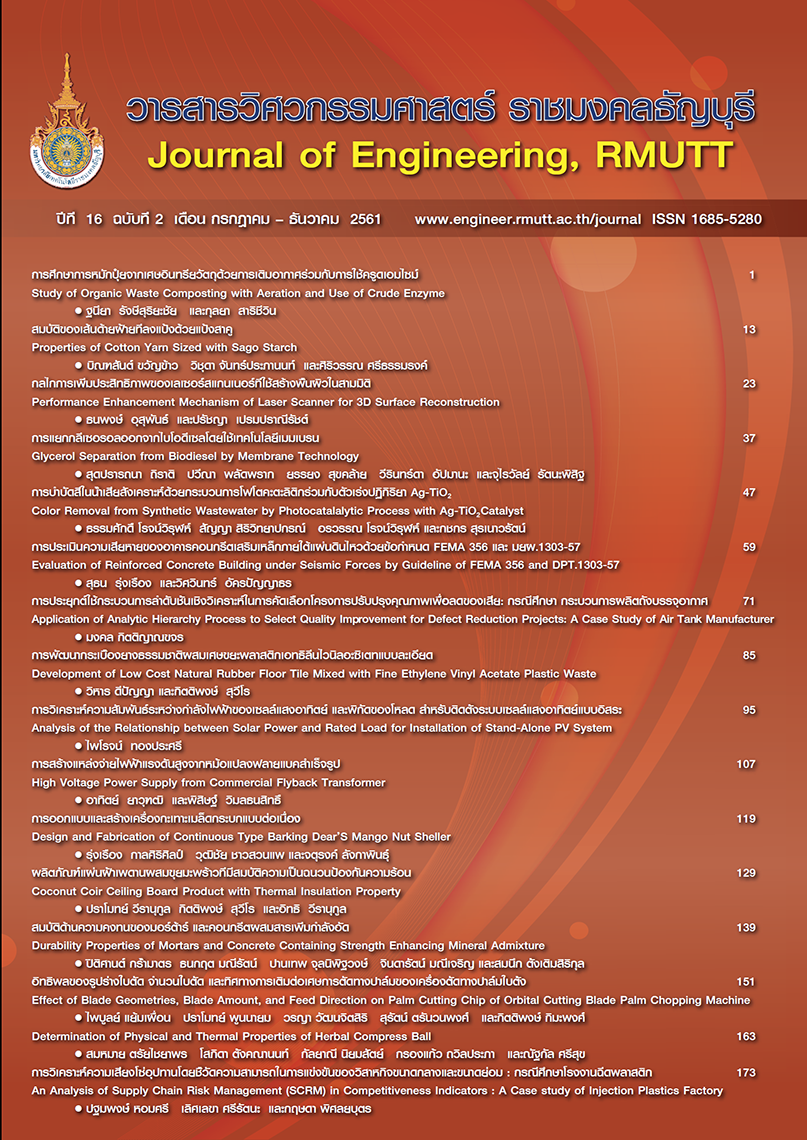การศึกษาการหมักปุ๋ยจากเศษอินทรียวัตถุด้วยการเติมอากาศ ร่วมกับการใช้ครูดเอมไซม์
Main Article Content
บทคัดย่อ
การศึกษาการหมักปุ๋ยจากเศษอินทรียวัตถุด้วยการเติมอากาศร่วมกับการใช้ครูดเอมไซม์ ได้แก่ ครูดเอมไซม์จากเชื้อเดี่ยว Trichoderma reesei และเชื้อผสมระหว่าง Trichoderma reesei และ Saccharomyces cerevisiae โดยศึกษาคุณลักษณะที่ได้จากการหมักปุ๋ยที่มีการเติมครูดเอมไซม์ผงทั้งสองแบบเปรียบเทียบกัน โดยการแปรเปลี่ยนปริมาณครูดเอมไซม์ที่เติมและปรับเวลาการเติมอากาศที่ 24 ชม. และเปิด-ปิด สลับกัน 6 ชม. จากผลการทดลองพบว่า อุณหภูมิในระหว่างการหมักของถังทั้ง 8 ถัง มีอุณหภูมิที่ใกล้เคียงกัน คืออยู่ในช่วงระหว่าง 28-41 องศาเซลเซียส ซึ่งถือว่าเป็นอุณหภูมิในช่วง Mesophilic ความชื้นในถังหมักปุ๋ยมีค่าอยู่ระหว่างร้อยละ 47-90 ซึ่งความชื้นสูงจะเกิดในช่วงต้นของการทดลองทำให้การหมักเกิดช้าในช่วงแรก เมื่อสิ้นสุดการทดลองค่าความเป็นกรด-ด่าง อยู่ในช่วง 8-9 และฟอสฟอรัสอยู่ในช่วงระหว่างร้อยละ 0.66-1.05 ในด้านคุณลักษณะของปุ๋ยหมักในเรื่องของธาตุอาหาร N, P, K เกือบทุกถังมีค่าเป็นไปตามมาตรฐานปุ๋ยหมัก ค่าอัตราส่วนคาร์บอนต่อไนโตรเจนของปุ๋ยหมักมีเฉพาะถังที่ 1 (มีการเติมอากาศ 24 ชั่วโมง เติมครูดเอนไซม์ 180 กรัม) ที่มีค่าเป็นไปตามมาตรฐานคือ 20:1 ถังที่ 2-8 มีค่าอัตราส่วนคาร์บอนต่อไนโตรเจนประมาณ 30:1 โดยเมื่อพิจารณารูปแบบการเติมอากาศที่ดีที่สุดคือมีการเติมอากาศตลอด 24 ชั่วโมง และถังที่ดีที่สุดคือ ถังที่ 1 ซึ่งมีวัสดุหมักร่วมกับครูดเอมไซม์ผงจากเชื้อเดี่ยวโดยมีการเติมอากาศ 24 ชั่วโมงร่วมกับการเติมครูดเอมไซม์ 180 กรัม
Article Details
บทความ ข้อมูล เนื้อหา รูปภาพ ฯลฯ ที่ได้รับการตีพิมพ์ในวารสารแนวหน้าวิจัยนวัตกรรมทางวิศวกรรม ถือเป็นลิขสิทธิ์ของวารสารฯ เท่านั้น ไม่อนุญาติให้บุคคลหรือหน่วยงานใดคัดลอกเนื้อหาทั้งหมดหรือส่วนหนึ่งส่วนใดไปเผยแพร่เพื่อกระทำการใด ๆ ที่ไม่ถูกต้องตามหลักจริยธรรม
เอกสารอ้างอิง
Pollution Control Department. Action Plan "Thailand Free of Garbage" according to the "public" guidelines for a year (2016-2017) [Internet]. 2016 [cited 2017 Jan 1]: [about 1 p.]. Available from: http://infofile.pcd.go.th/waste/
ThaiPlans%20without%20Waste.pdf?CFID=2929130&CFTOKEN=49324635 (in Thai)
Srisatit T. Municipal Solid Waste Management Engineering. 1st ed. Bangkok: The Engineering Institute of Thailand under H.M. The King’s Patronage; 2015. (in Thai)
Siwarasak P, Yaowalak T, Jutarat N, Nirun J, Tom M. Crude Enzyme Powder Utilization for Ethanol Fermentation from Pineapple Skins. 7th Conference On Energy Network of Thailand. 2011 May 3-5:13-8. (in Thai)
Siwarasak P, Pajantagate P, Prasertlertart K. Use of Trichoderma reesei RT-P1 Crude Enzyme Power for Ethanol Fermentation of Sweet Sorghum Fresh Stalks. Bioresource Technology. 2012;107:200-4.
Zhang L, Sun X. Effects of Earthworm Casts and Zeolite on the Two-Stage Composting of Green Waste. Waste Management. 2015;39: 119-29.
Karnchanawang S, Suriyanon N. 2011. Household Organic Waste Composting using Bins with different types of passive aeration. Resource, Conservation and Recycling. 2011;55: 548-53.
Saricheewin K, Rangseesuriyachai T. Composting of Organic Waste Using Aeration Tank. Journal of Engineering, RMUTT. 2016;14(1):25-34. (in Thai)
Department of Agriculture. Manual of Organic Fertilizer Analysis. 1st ed. Bangkok: Department of Agriculture; 2008. (in Thai)
Manu, M.K., Kumar, R., Garg, A.. 2017. Performance Assessment of Improved Composting System for Food Waste with Varying Aeration and Use of Microbial Inoculum. Bioresource Technology. 2017;234: 167-77.
Osotspa Y, Wongmaneeroj A, Hongprayun C.Fertilizer for Sustainable Agriculture. 2nd ed. Bangkok: Kasetsart University Press; 2011. (in Thai)
Gaur A.C., Sadasivan K.U., Mathur R.S., Magu S.P. Role of Mesophilic Fungi in Composting. Agricultural Waste. 1982;4:453-60.
Martins O., Dewes T. Loss of nitrogenous compounds during composting of animal wastes. Bioresource Technology. 1992;42: 103-11.
Land Developement Department. Operational Guide: Plant, Fertilizer and Soil Analysis Processes [Internet]. 2010 [cited 2017 Sep 16]: [about 1 p.]. Available from: http://www.ldd.go.th/PMQA/ 2553/Manual/OSD-07.pdf (in Thai)
Chanchampee P. Thermophilic Composting of Food Waste and Farm Residue by Rotary Drum [dissertation]. Chiangmai: Chiangmai University; 1998. (in Thai)
Sánchez C. Lignocellulosic Residues: Biodegradation and Bioconversion by Fungi. Biotechnology Advance. 2009; 27:185-94.
Mohammad N., Zahaagir Alam Md., Nassereldeen A.K., Amimul, A. Effective Composting of Oil Palm Industrial Waste by Filamentous: A review. Resources Conservation and Recycling. 2012;58:69-78.
Zhisheng Y, Hongxun, Z. Ethanol Fermentation of Acid-Hydrolyzed Cellulosic Pyrolysate with Saccharomyces cerevisiae. Bioresource Technology. 2004;93: 199-204.
Rui G., Guoxue L., Tao J., and et al. Effect of aeration rate, C/N ratio and moisture content on the stability and maturity of compost. Bioresource Technology. 2012;112:171-78.


